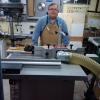Never used a jointer/planer much but know that I have one I'm sure that will change. I know that you should plane with the grain and that you change the pressure to the out-feed table. I also know that you can get kickback on a jointer so...
which side of the blade is most dangerous? The in-feed or the out-feed?
I know that both should be treated as dangerous but when thinking about the dynamics involved I started wonder which table was the most dangerous.





 Reply With Quote
Reply With Quote



